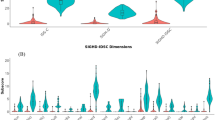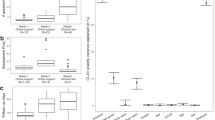Abstract
In the study, we developed a smartphone-based electronical scale validity assessment framework. 374 college students are recruited to fill in Beck Depression Inventory. A total of 544 filling of scales are collected, which may be filled accordingly or concealed. Via an electronical scale based WeChat applet and backend application, temporal and spatial behavioral data of subjects during the scale-filling process are collected. We established an assessment model of the validity of the scale-filling based on the behavior data with machine learning approaches. The result shows that smartphone behavior has significant features in the dimension of time and space under different motivations. The framework achieves an valuable assessment of the effectiveness of the scale, whose key indicators such as accuracy, sensitivity and precision are over 80% under multiple dimension behavior data classification. The framework has a good application prospect in the field of psychological screening.
Access this chapter
Tax calculation will be finalised at checkout
Purchases are for personal use only
Similar content being viewed by others
References
Schwarzer, R., Mueller, J., Greenglass, E.: Assessment of perceived general selfefficacy on the internet: data collection in cyberspace. Anxiety Stress Coping 12(2), 145–161 (1999)
Statistical Report on Internet Development in China (2018)
Chen, J.Y., Zheng, H.T., Xiao, X., Sangaiah, A.K., Jiang, Y., Zhao, C.Z.: Tianji: implementation of an efficient tracking engine in the mobile Internet era. IEEE Access 5, 16592–16600 (2017)
Harari, G.M., Müller, S.R., Aung, M.S., Rentfrow, P.J.: Smartphone sensing methods for studying behavior in everyday life. Curr. Opin. Behav. Sci. 18, 83–90 (2017)
Boonstra, T.W., Nicholas, J., Wong, Q.J., Shaw, F., Townsend, S., Christensen, H.: Using mobile phone sensor technology for mental health research: integrated analysis to identify hidden challenges and potential solutions. J. Med. Internet Res. 20(7), e10131 (2018)
Gong, J., et al.: Understanding behavioral dynamics of social anxiety among college students through smartphone sensors. Inf. Fusion 49, 57–68 (2019)
Drummond, H.E., Ghosh, S., Ferguson, A., Brackenridge, D., Tiplady, B.: Electronic quality of life questionnaires: a comparison of pen-based electronic questionnaires with conventional paper in a gastrointestinal study. Qual. Life Res. 4(1), 21–26 (1995)
Pouwer, F., Snoek, F.J., Van Der Ploeg, H.M., Heine, R.J., Brand, A.N.: A comparison of the standard and the computerized versions of the Well-being Questionnaire (WBQ) and the Diabetes Treatment Satisfaction Questionnaire (DTSQ). Qual. Life Res. 7(1), 33–38 (1997)
Velikova, G., et al.: Automated collection of quality-of-life data: a comparison of paper and computer touch-screen questionnaires. J. Clin. Oncol. 17(3), 998 (1999)
Ryan, J.M., Corry, J.R., Attewell, R., Smithson, M.J.: A comparison of an electronic version of the SF-36 General Health Questionnaire to the standard paper version. Qual. Life Res. 11(1), 19–26 (2002)
Carmines, E.G., Zeller, R.A.: Reliability and Validity Assessment, vol. 17. Sage Publications, Thousand Oaks (1979)
Nieuwenhuijsen, K., De Boer, A.G.E.M., Verbeek, J.H.A.M., Blonk, R.W.B., Van Dijk, F.J.H.: The depression anxiety stress scales (DASS): detecting anxiety disorder and depression in employees absent from work because of mental health problems. Occup. Environ. Med. 60(Suppl 1), i77–i82 (2003)
Guo, Y., Hu, X., Hu, B., Cheng, J., Zhou, M., Kwok, R.Y.: Mobile cyber physical systems: current challenges and future networking applications. IEEE Access 6, 12360–12368 (2017)
Hu, X., et al.: Emotion-aware cognitive system in multi-channel cognitive radio ad hoc networks. IEEE Commun. Mag. 56(4), 180–187 (2018)
Beck, A.T., Ward, C.H., Mendelson, M., Mock, J., Erbaugh, J.: An inventory for measuring depression. Arch. Gen. Psychiatry 4(6), 561–571 (1961)
Al-Anazi, A., Gates, I.D.: A support vector machine algorithm to classify lithofacies and model permeability in heterogeneous reservoirs. Eng. Geol. 114(3-4), 267–277 (2010)
Cover, T., Thomas, M., Peter, E.: Nearest neighbor pattern classification. IEEE Trans. Inf. Theory 13(1), 21–27 (1967)
Zhang, B., Srihari, S.N.: Fast k-nearest neighbor classification using cluster based trees. IEEE Trans. Pattern Anal. Mach. Intell. 26(4), 525528 (2004)
Hart, P.: The condensed nearest neighbor rule (Corresp.). IEEE Trans. Inf. Theory 14(3), 515–516 (1968)
Yu, X.-G., Yu, X.-P.: The research on an adaptive k-nearest neighbors classifier. In: 2006 International Conference on Machine Learning and Cybernetics, pp. 1241–1246. IEEE (2006)
Acknowledgment
This work was supported in part by the National Natural Science Foundation of China [Grant No. 61632014, No. 61627808, No. 61210010], in part by the National Basic Research Program of China (973 Program) under Grant 2014CB744600, in part by the Program of Beijing Municipal Science & Technology Commission under Grant Z171100000117005.
Author information
Authors and Affiliations
Corresponding author
Editor information
Editors and Affiliations
Rights and permissions
Copyright information
© 2019 Springer Nature Switzerland AG
About this paper
Cite this paper
Yang, M., Tang, J., Tang, L., Hu, B. (2019). Smartphone Behavior Based Electronical Scale Validity Assessment Framework. In: Cui, Z., Pan, J., Zhang, S., Xiao, L., Yang, J. (eds) Intelligence Science and Big Data Engineering. Big Data and Machine Learning. IScIDE 2019. Lecture Notes in Computer Science(), vol 11936. Springer, Cham. https://doi.org/10.1007/978-3-030-36204-1_35
Download citation
DOI: https://doi.org/10.1007/978-3-030-36204-1_35
Published:
Publisher Name: Springer, Cham
Print ISBN: 978-3-030-36203-4
Online ISBN: 978-3-030-36204-1
eBook Packages: Computer ScienceComputer Science (R0)




